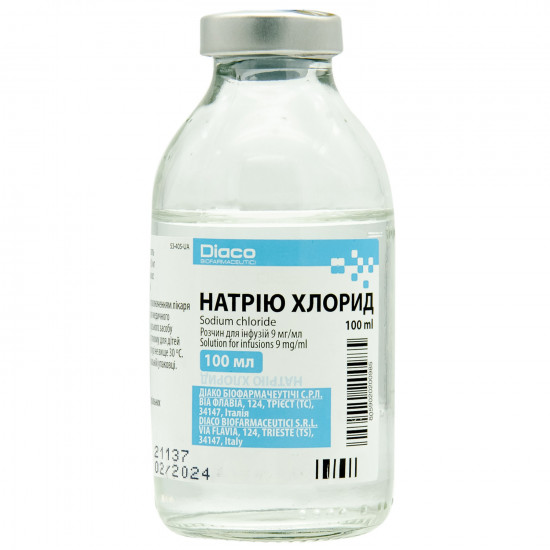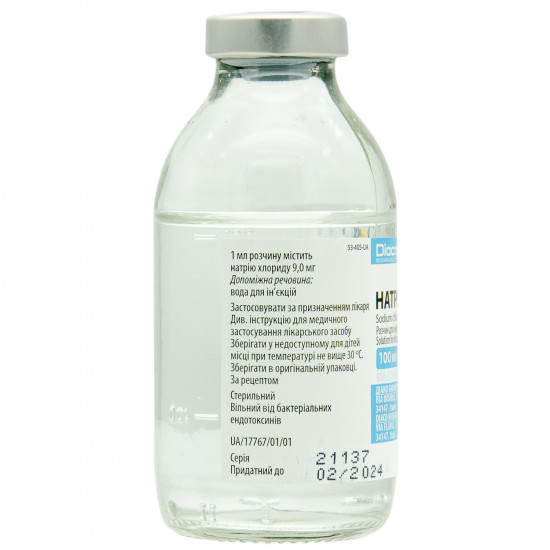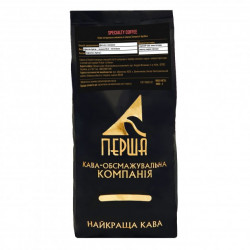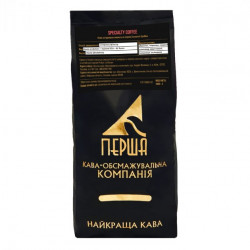



- Stock: In Stock
- Model: 176647
0% Customers recommend this product
-
5 Awesome0%
-
4 Great0%
-
3 Average0%
-
2 Bad0%
-
1 Poor0%
Reviews Over Sodium chloride (physical. solution) solution for inf. 0.9% quarrystone. 100 ml
- (0)
Total Reviews (0)
click here write review to add review for this product.
Report this review.
Description
Solution "Sodium chloride" is applied to infusions at the following indications:
- for treatment of isotonic extracellular dehydration;
- for treatment of a hyponatremia;
- for cultivation of compatible medicines for parenteral administration.
Structure
Active ingredient - sodium chloride (1 ml of solution contains sodium of chloride 9.0 mg).
Excipient - water for injections.
Contraindication
- hypersensitivity to acting or to excipients; to
- solution is contraindicated to patients with a hypernatremia or a hyperchloremia;
- when using medicine as solvent needs to consider the contraindications concerning medicines which are dissolved.
Route of administration
Recommended dose can be calculated in mekv or sodium mmol, mass of ions of sodium or mass of sodium chloride (1 g of NaCl = 394 mg of Na + either 17.1 mekv or 17.1 mmol of Na + and Clyu).
Dose, speed and duration of introduction have to be calculated byaccording to several factors, including age, weight, a clinical condition, the accompanying treatment and, in particular, a condition of hydration of the patient and the response to treatment taking into account these laboratory researches. The balance of liquid and concentration of electrolytes of plasma have to be controlled during treatment.
Recommended doses
Recommended doses for treatment of isotonic extracellular dehydration and a hyponatremia:
- adult - from 500 ml to 3 l a day;
- children - from 20 to 100 ml/kg/days depending on age and body weight.
Recommended dose at application as solvent for joint medicines - from 50 to 250 ml for one medicament dose.
in case of use of sodium of chloride of 0.9% as solvent for infusion of compatible medicines of dosing and the speed of infusion has to be defined also by character and the mode of dosing of joint medicine.
Way of use
Solution is entered intravenously infusionally with use of a sterile depyrogenized system for injection with observance of rules of an asepsis. The system for injection has to be filled with solution for prevention of hit of air in a system.
solution has to be visually checked byBefore introduction for existence of mechanical inclusions and discoloration. Not to use if solution opaque, there are mechanical inclusions or packing is damaged.
Additional medicines can be added bybefore infusion or during infusion through an infusional system.
Pregnant
Data on use of sodium of chloride of 0.9% during pregnancy and feeding by a breast are limited to
Feature of application
. Before chloride sodium introduction the doctor has to estimate potential risks and advantage in each separate case. It is recommended to apply with care to patients with a preeclampsia.in case of addition of medicine needs to consider separately the mechanism of effect of medicine and expediency of its use during pregnancy and in the period of a lactation.
Children
to Children at isotonic extracellular dehydration and a hyponatremia to enter from 20 to 100 ml/kg/days depending on age and body weight.
needs to control carefully concentration of electrolytes in blood plasma as the ability to regulate water and electrolytic balance at patients of children's age can be reduced. Repeated infusions of sodium of chloride should be carried out only after determination of level of sodium in blood serum.
Overdose
Cumulative adverse effects of excess of sodium in an organism include nausea, vomiting, diarrhea, spasms in a stomach, I am eager, reduction of salivation and dacryagogue, perspiration, fervescence, tachycardia, a hypertension, a renal failure, peripheral hypostases and a fluid lungs, an apnoea, a headache, dizziness, uneasiness, irritability, weakness, muscular twitchings and rigidity, spasms, a coma and a lethal outcome.
Excessive introduction of 0.9% of sodium of chloride can leadto a hypernatremia (that can cause violations from the central nervous system (CNS), including convulsive attacks, a coma, wet brain and death) and overloads sodium (that can cause the central and/or peripheral hypostasis). The patient should provide the specialized help.
Excess amount of chloride in an organism can leadto loss of bicarbonate with podkislivayushchy effect.
signs and symptoms of overdose will be connected byin case of application of 0.9% of sodium of chloride as solvent for other medicines with the nature of the dissolved medicines. In case of overdose the treatment needs to be stopped, the patient should be examined on existence of the corresponding signs and symptoms connected with medicine introduction. As required it is necessary to host the corresponding and supporting actions.
Side effectsFollowing side reactions were registered by
during the post-marketing period. Frequency of side reactions cannot be estimated on the available data.
Neurologic frustration: tremor.
Vascular frustration: hypotension.
from skin and hypodermic cellulose: urticaria, rash, itch.
Storage conditionsto Store
in original packing at a temperature not above 30 °C, out of children's reach.
Expiration date - 3 years.
Specifications
| Characteristics | |
| Active ingredients | Sodium chloride |
| Amount of active ingredient | 9 mg/ml |
| Applicant | Diako Biofarmacheutichi |
| Code of automatic telephone exchange | B05XA03 Sodium chloride |
| Interaction with food | It doesn't matter |
| Light sensitivity | Not sensitive |
| Market status | Generic-generic |
| Origin | Chemical |
| Prescription status | According to the prescription |
| Primary packing | bottle |
| Producer | S.R. DIAKO BIOFARMACHEUTICHI. L. |
| Quantity in packing | 100 ml |
| Release form | solution for infusions |
| Route of administration | Infusional |
| Sign | Import |
| Storage temperature | from 5 °C to 25 °C |
| Trade name | Sodium chloride |




















